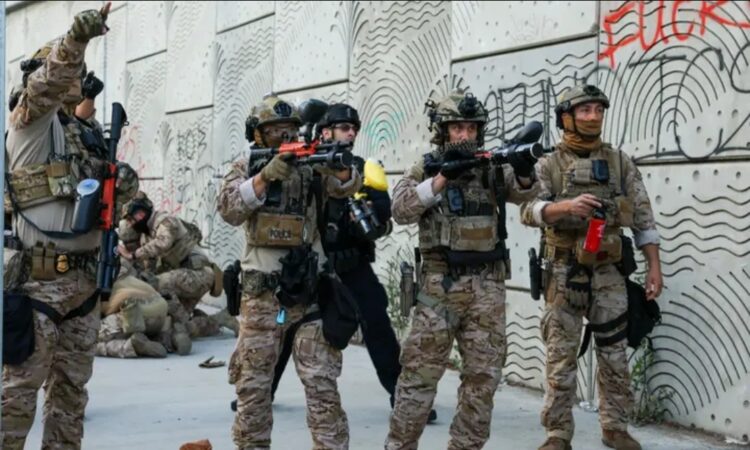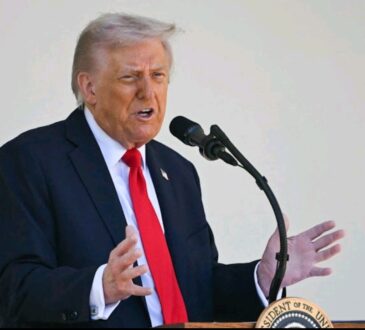
A group of soldiers in camouflage uniforms carrying non-lethal weapons walked past some graffiti that said “Fuck ICE.” They were federal agents in Los Angeles, trying to manage protests that had erupted following a wave of immigration raids that started on June 12, 2025.
On Thursday night, a federal judge named Charles Breyer made a bold legal move. He ruled that former President Donald Trump had illegally taken control of California’s National Guard to suppress these protests. Normally, the National Guard answers to state governors. But Trump had used federal power to override California Governor Gavin Newsom’s authority, sending the Guard into Los Angeles without Newsom’s permission. Judge Breyer said this wasn’t allowed and issued a temporary order to stop it. However, that order was immediately paused by an appeals court, which will reconsider the matter in an emergency hearing on Tuesday.
Legal experts Dahlia Lithwick and Mark Joseph Stern discussed the case. They praised Judge Breyer for being honest and clear about the facts. Instead of just accepting the government’s version of events, he took the time to explain what’s really happening: the protests in Los Angeles are mostly peaceful, not violent rebellions as Trump claimed.
The government tried to argue that these protests were a threat serious enough to justify federal military intervention. But Judge Breyer disagreed. He said that while a few people may have caused damage or lit fireworks, that doesn’t mean the entire protest is a rebellion. He emphasized that the Constitution protects peaceful protests under the First Amendment, and you can’t take away people’s rights just because a few outliers break the rules.
Breyer’s ruling is especially important because the case is likely to end up in higher courts, maybe even the Supreme Court. His opinion lays out the facts clearly, which will matter a lot as the legal battle continues—not just over laws, but over what’s actually true.
California made both legal and constitutional arguments. Legally, they said Trump had used the wrong law. If a president wants to take control of a state’s National Guard, he usually has to use the Insurrection Act, which is meant for extreme cases like riots or uprisings. That law also lets the president bypass state governors if things are truly out of control. But Trump didn’t use that law. He used a different one, which only applies in limited cases, like a rebellion—and even then, it has to go “through the governor.” But Trump ignored Newsom’s objections and tried to take command anyway.
To make it look legal, Trump’s Department of Defense simply added the phrase “through the governor of California” at the top of the orders, even though Newsom never agreed. Judge Breyer called this out as a sham and said it didn’t meet the legal requirements.
California also said Trump had violated the 10th Amendment of the Constitution, which says that states have certain rights and powers that the federal government can’t take away. The National Guard is one of those powers—unless the president follows the law and properly federalizes them, which, according to Breyer, Trump did not. Because of Trump’s actions, Governor Newsom wasn’t able to use the Guard for things like wildfire response, which he has the right to do. Breyer ruled that this was a constitutional violation.
This part of the ruling is groundbreaking, mostly because we’ve never had a case quite like this before—a president taking over a state’s National Guard against the state’s will without following proper legal steps. That’s why it’s so uncertain what the higher courts will decide.
It’s also important to note that this case only deals with the National Guard—not the Marines, who are still on the ground in Los Angeles. Unlike the National Guard, Marines are trained for combat, not crowd control. Their presence is deeply troubling to many.
After Judge Breyer’s decision, the 9th Circuit Court of Appeals put a temporary hold on it. That court includes two judges appointed by Trump, but they’re not known for being extreme. The third judge was appointed by Biden. Even though Breyer had already paused his own order for a couple days, the appeals court added their own hold to give the case time to be reviewed properly.
Everyone expects that if the appeals court supports even part of Breyer’s decision, the federal government will rush to ask the Supreme Court to step in. There’s concern that the conservative-leaning justices on the Supreme Court will side with Trump, especially given their past support for expanding presidential power—sometimes at the expense of state rights and other branches of government.




